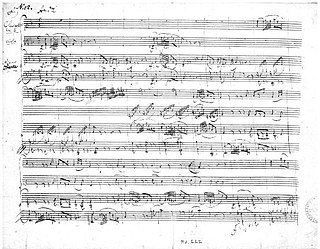Related Research Articles
In music, a quartet is an ensemble of four singers or instrumental performers.

The viola ( vee-OH-lə, Italian:[ˈvjɔːla,viˈɔːla]) is a string instrument that is usually bowed. Slightly larger than a violin, it has a lower and deeper sound. Since the 18th century, it has been the middle or alto voice of the violin family, between the violin (which is tuned a perfect fifth higher) and the cello (which is tuned an octave lower). The strings from low to high are typically tuned to C3, G3, D4, and A4.

The term string quartet refers to either a type of musical composition or a group of four people who play them. Many composers from the mid-18th century onwards wrote string quartets. The associated musical ensemble consists of two violinists, a violist, and a cellist. The double bass is almost never used in the ensemble mainly because it would sound too loud and heavy.

Chamber music is a form of classical music that is composed for a small group of instruments—traditionally a group that could fit in a palace chamber or a large room. Most broadly, it includes any art music that is performed by a small number of performers, with one performer to a part. However, by convention, it usually does not include solo instrument performances.

In classical music, a piano quintet is a work of chamber music written for piano and four other instruments, most commonly a string quartet. The term also refers to the group of musicians that plays a piano quintet. The genre flourished during the nineteenth century.
A piano trio is a group of piano and two other instruments, usually a violin and a cello, or a piece of music written for such a group. It is one of the most common forms found in classical chamber music. The term can also refer to a group of musicians who regularly play this repertoire together; for a number of well-known piano trios, see below.

The Paganini Quartet was an American string quartet founded by cellist Robert Maas and violinist Henri Temianka in 1946. The quartet drew its name from the fact that all four of its instruments, made by Antonio Stradivari (1644–1737), had once been owned by the great Italian violinist and composer Niccolo Paganini (1782–1840).
A major is a major scale based on A, with the pitches A, B, C♯, D, E, F♯, and G♯. Its key signature has three sharps. Its relative minor is F-sharp minor and its parallel minor is A minor. The key of A major is the only key where the Neapolitan sixth chord on requires both a flat and a natural accidental.
D minor is a minor scale based on D, consisting of the pitches D, E, F, G, A, B♭, and C. Its key signature has one flat. Its relative major is F major and its parallel major is D major.

Rudolf Firkušný was a Moravian-born, Moravian-American classical pianist.
Discography for the cellist Yo-Yo Ma.

A clarinet–viola–piano trio, often titled "Trio for Clarinet, Viola and Piano" is a work of chamber music that is scored for clarinet, viola, and piano; or is the designation for a musical ensemble of a group of three musicians playing these instruments. This combination of instruments differs from other combinations, as the viola and the clarinet share approximately the same musical range, but not the same tone quality.

Lars Vogt was a German classical pianist, conductor and academic teacher. Noted by The New York Times for his interpretations of Brahms, Vogt performed as a soloist with major orchestras, including the Berlin Philharmonic. He was the music director of the Orchestre de chambre de Paris at the time of his death and also served as the music director of the Royal Northern Sinfonia. He ran a festival of chamber music, Spannungen, from 1998, and succeeded his teacher Karl-Heinz Kämmerling as professor of piano at the Musikhochschule Hannover.
The Melos Ensemble is a group of musicians who started in 1950 in London to play chamber music in mixed instrumentation of string instruments, wind instruments and others. Benjamin Britten composed the chamber music for his War Requiem for the Melos Ensemble and conducted the group in the first performance in Coventry.
Leonard Hokanson was an American pianist who achieved prominence in Europe as a soloist and chamber musician.
The 2012 Echo Klassik Awards were held on October 14, 2012. It is the 20th edition of the annual Echo Klassik awards for classical music. The ceremony took place in the Konzerthaus Berlin and was broadcast on ZDF. It was hosted by Nina Eichinger and Rolando Villazón and organised by The German Music Industry Association.

The Abegg Trio was a German piano trio. Since its foundation in 1976, it played in the original line-up.

Antje Weithaas is a German classical violinist. Apart from solo recitals and chamber music performances, she has played with leading orchestras in Europe, Asia and the United States.
The Fauré Quartet is a German piano quartet, named after Gabriel Fauré. Founded in 1995, they have performed internationally and recorded, including works written for them by composers such as Volker David Kirchner and Toshio Hosokawa.
The Bartók Quartet is a Hungarian string quartet ensemble, founded in 1963 in Budapest as the successor ensemble of the Komlós Quartet (1957–63).
References
- ↑ Franz Berwald, short biography and list of works
- ↑ "Object Metadata".
- ↑ James Francis Brown – Works – Piano Quartet (accessed 13 October 2015)
- ↑ "Object Metadata".
- ↑ Willkommen bei Klassik Heute at www.klassik-heute.de
- ↑ "Selga Mence | LMIC".